Capsule hotels have come a long way since the first of its kind was introduced in 1979. Today, they represent not just the consequences of missing the last train or partying too hard, but also unique and practical accommodation for travellers. Nine Hours is a popular capsule hotel chain at the forefront of this progression. Its name suggests a very fundamental form of a hotel stay, consisting of one hour to shower, seven hours to sleep, and one hour to get dressed.
While each Nine Hours property is designed differently (they are designed by different architects), the same brand standards apply across them. Just as all Westins feature its signature Heavenly Bed regardless of location, Nine Hours brings a consistent capsule hotel experience to all its hotels across Tokyo, Kyoto, and Osaka. The result is a simple, seamless, and futuristic experience. Of course, Nine Hours Hamamatsucho is no exception.
 |
| Nine Hours capsule hotel sleeping pod |
A convenient location
This hotel is situated just beside Daimon Station, providing easy access to Toei's Asakusa and Oedo subway lines. Moreover, it is also a few steps from Hamamatsucho Station, which serves the JR Yamanote Line, Keihin-Tōhoku Line, and the Tokyo Monorail. Major destinations around Tokyo—such as Asakusa, Akihabara, and Ginza—are all thus a direct subway ride away. Importantly, the Tokyo Monorail provides convenient access to Haneda Airport, with the non-stop Haneda Express trains reaching each of the three terminals in under 20 minutes (the Local and Rapid trains do stops along the way).
 |
| Nine Hours Hamamatsucho |
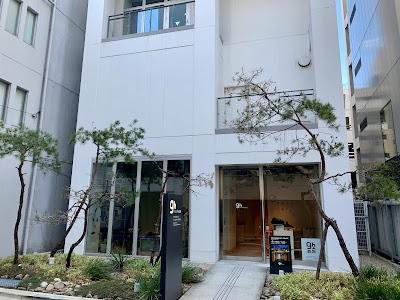 |
| Hotel exterior |
The hotel is within a 10-minute walk to nearby attractions like the famous Tokyo Tower, the Zojo-ji Buddhist temple, and Shiba Park. The Kyu-Shiba-rikyu and Hamarikyu Gardens are also not far away.
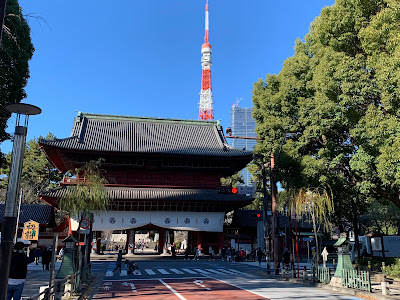 |
| Zojo-ji Sange Datsumon Gate |
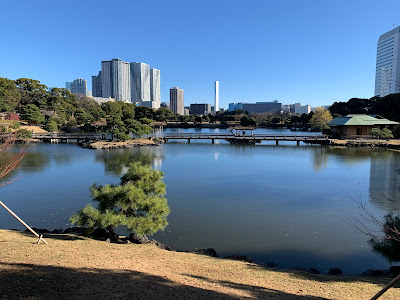 |
| Hamarikyu Gardens |
Step 1: Check-in
There are about a couple hundred capsules for both genders (some Nine Hours locations, like the ones in Kanda and Shinjuku, cater to women only). Like a typical hotel, guests check in at the reception desk on the ground floor. But unlike a regular hotel key card, guests a given a flimsy printed plastic card that states the Wi-Fi password, their stay dates, pod number, and a QR code for locker access. An amenity pack is also handed out; it is a new set per day, comprising towels, loungewear, disposable slippers, and a toothbrush set. Guests who booked a breakfast package will get a coupon for the nearby Tully's Coffee; there is no in-house cafe here.
At the reception is a minibar with bottled water and drinks available for purchase; otherwise, there is no shortage of nearby convenience stores with 7-11, Family Mart, and Lawson all just 100 metres away in the nearby streets. There is also a self-service luggage rack, monitored by CCTV, for guests who wish to deposit their luggage before check-in and after check-out (note that guests must check out before 10 am daily, even if they are staying for multiple nights).
 |
| Reception desk at Nine Hours Hamamatsucho |
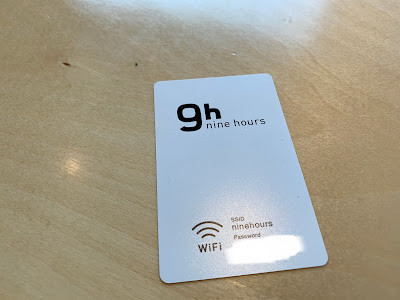 |
| Nine Hours QR key card |
As printed on the wall, the Nine Hours experience can be broken down into a four-step process: check-in → locker → shower → sleep pod. The hotel is also plastered with similar infographics and signposts throughout, alongside words in Japanese and English, making it easy for international travellers to navigate.
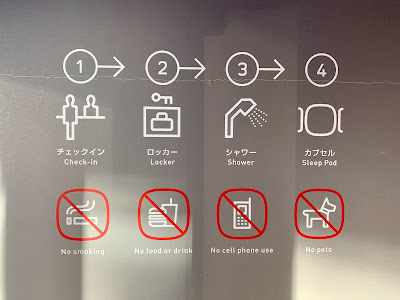 |
| Check-in, locker, shower, sleep pod |
So after check-in, the next step is for guests to proceed upstairs to the lockers. Note that the elevators here are gender-specific. The male-only elevator leads to the male floors (lockers, showers, and pods); female-only elevator leads to female floors. Additionally, both elevators lead to the lounge on level 10.
 |
| Male-only elevator |
 |
| Separate elevators for men and women, seen on level 10 |
Step 2: Locker
The hotel provides one locker per guest; the locker number is equivalent to the pod number. Guests can refer to the map and follow the numbers on the floor to navigate to their designated lockers. The lockers are unlocked using the given QR code, and they are locked with just a push of the locker door. This means that guests should always carry their plastic card around (and not accidentally lock it in the locker!). Note that after 10 am on the day of check-out, the QR code will automatically cease to work.
 |
| Navigating the locker room |
Beneath the lockers is an open space for guests to store more bulky but less valuable items. The locker area is monitored by CCTV.
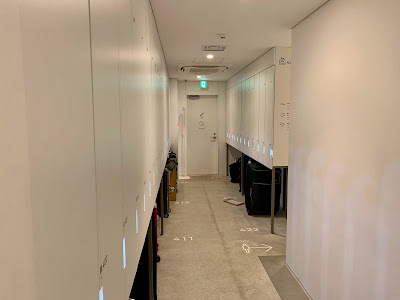 |
Navigating the locker room
|
Guests should change into the disposable slippers here. They can also wear the loungewear provided, as most guests do within the hotel (unless you are going to the outdoor terrace outside of summer). The pants contain a back pocket to keep the key card.
Step 3: Shower
The shower area is adjacent to the locker area. There are almost a dozen showers, each as individual rooms, like those of an airport lounge. The toilets are separate from the showers. The "warm pillar" showers, as they call it, features a "straight columnar spray pattern" that traps heat and delivers warm droplets. Combined with great water pressure, I think it even beats the showers of some older 5-star hotels. Shower gel, shampoo, and hair conditioner is provided in each shower.
 |
| Nine Hours "warm pillar" shower |
There are fewer toilets than showers on this floor, but additional toilets are available on the floors housing the sleep pods. These TOTO toilets come with bidets, as one would expect in Japan. There is also a very small sink in each toilet for a quick wash of hands.
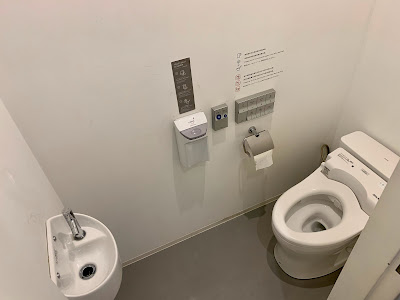 |
| TOTO toilet |
The washing and grooming area outside the showers consists of a long row of sinks and hairdryers. The water from the tap here is safe for drinking.
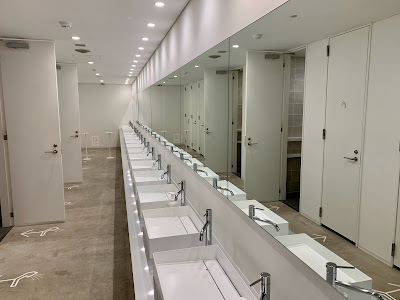 |
| Washing area |
4. Sleep pods
The fourth step is arguably the most important part of the Nine Hours experience. Each floor contains about 30 sleep pods, and their pod numbers are clearly marked both on the ground and on each pod. Shoes are prohibited on this floor; guests should wear the disposable slippers provided.
 |
| Sleeping pods on level 5 |
There are two levels of pods stacked on each other; the odd-numbered ones are below, while the even-numbered ones are on top and accessible through through an easy climb. One will quickly notice that they are thoughtfully designed. As opposed to a traditional capsule hotel, the upper pods are staggered from the lower pods, which means that there is no one directly above or below any guest. The alignment of the steps with the entrance of the upper pod also provides a more direct path for climbing in. Another difference is that each pod is more rounded than boxy; both the pod entrance and the mattress are rounded. The walls are also pretty solid material, which reduces the transmission of sound and vibration to adjacent pods.
 |
| Walkway to the sleeping pods |
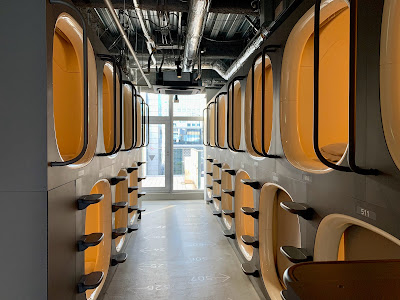 |
| More sleeping pods |
Every pod is identical to each other; there are no bed choices, city views, or suites available. But there are some pods (e.g. 521 pictured below) that offer a bit more privacy and less foot traffic, just like the corner room of a regular hotel. Regardless, the sleeping area was quiet, and there are signs on the wall reminding guests not to talk on their cell phones. This is also not the place to socialise or pack your luggage!
 |
| The "corner pod" |
Within each pod, there is a rounded mattress, and rounded pillow, and a blanket. Two corners for storing small items like phones and wallets are on the wall. There is also an electrical port (for Japanese plug types A and B, i.e. two flat pins), a USB port, and a room light that can be adjusted to the desired brightness. A curtain at the pod entrance can be drawn for privacy, but it cannot be locked as per Japanese law. There is no TV available in the pod (some capsule hotels do).
 |
| Nine Hours pod interior -- rounded mattress and pillow |
 |
| Charging pod, light switch, and USB port |
Comfortable lounge spaces
This hotel offers quite a few common spaces for guests to use. To begin with, there is a small reading area on level 8 for guests to use, consisting of high chairs by the window. There are no blinds and it can be very bright in the day.
 |
| Reading area on level 8 |
 |
| Desks and high chairs by the window |
Next, the main lounge area is on level 10, which offers about 30 seats. There is a large communal table in the middle, a row of seats facing the Tokyo Tower, and another table in a corner. They are equipped with power outlets. Guests can eat their takeaways from the convenience store or depachika (department store basement markets) here. There is, however, no microwave or refrigerator here.
 |
| Lounge area |
The seats by the window here feature an impressive view of the Tokyo tower, which lights up in the evenings.
 |
| View of Tokyo tower by day |
 |
| View of Tokyo tower by night (Christmas lighting) |
Additionally, there are also two outdoor terraces. The first one is just outside the same floor. Food and smoking are prohibited in the outdoor terraces, and also the rest of the hotel except at the main indoor lounge.
 |
| Outdoor terrace on level 10 |
The second outdoor terrace is much bigger and can be accessed by taking the stairs from level 10 to the rooftop. Here, guests can enjoy a 360-degree view of the surrounding buildings, and of course, the prominent Tokyo Tower.
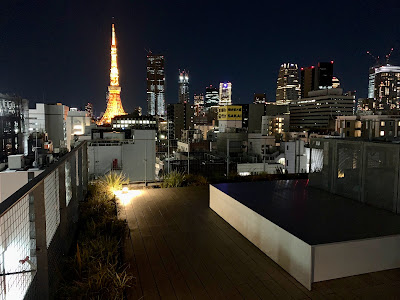 |
| Outdoor terrace on the rooftop |
Overall review
Nine Hours has almost become the gold standard by which I measure other capsule hotels. It is always clean and modern. The experience is seamless, even therapeutic. It doesn't need free upgrades, welcome drinks, late checkouts, or other fancy distractions to win guests over.
Still, with the overwhelming variety of capsule hotels—and other accommodation types—in Tokyo, I offer a few pros and cons of staying here.
Pros:
- Easy airport access
- Tokyo Haneda Airport (HND) — reach Terminal 3 (for most international flights) from Hamamatsucho station in as quickly as 13 minutes, on Haneda Express of the Tokyo Monorail, for just ¥500! This makes the hotel a good choice for those on short stopovers.
- Tokyo Narita Airport (NRT) — the Keisei Narita Skyaccess reaches Daimon station without transfers for ¥1,350. Else, Tokyo station has several other options and is just two stops away from Hamamatsucho station on the JR Yamanote line
- Easy access to multiple subway lines — Asakusa, Oedo, Yamanote lines are nearby and reach most tourist destinations in Tokyo
- Nearby food options — izakaya bars, restaurants (Ippudo), 24-hour food (Fuji Soba), and convenience stores (7-11, Family Mart, Lawson) are really all just steps away
- Consistent Nine Hours brand standard — whether you are at the Nine Hours at Suidobashi, Otemachi or Shinjuku-North, you get a safe, clean, and cheap shower/sleep experience
Cons:
- Daily check-in and check-out — a strict 10 am daily checkout applies, even if staying for multiple nights, which may either be troublesome or a healthy daily routine. It also means the hotel will expend a new set of towels, loungewear, and disposables every day.
- No premium pods available — since every pod is identical, there are no options available to suit individual needs and budgets, unlike chains like First Cabin which offer different pod types. But equality does have its merits ...
- No public bath and sauna facilities — many other Japanese hostels and spas offer them for free
- No kitchen facilities — and also no fridge and microwave, so this hotel is not suitable for guests wishing to cook their meals
Nine Hours Hamamatsucho
1 Chome-25-10 Hamamatsucho, Minato City, Tokyo 105-0013, Japan
































Comments
Post a Comment
Thank you for commenting on Hotel Hobby!